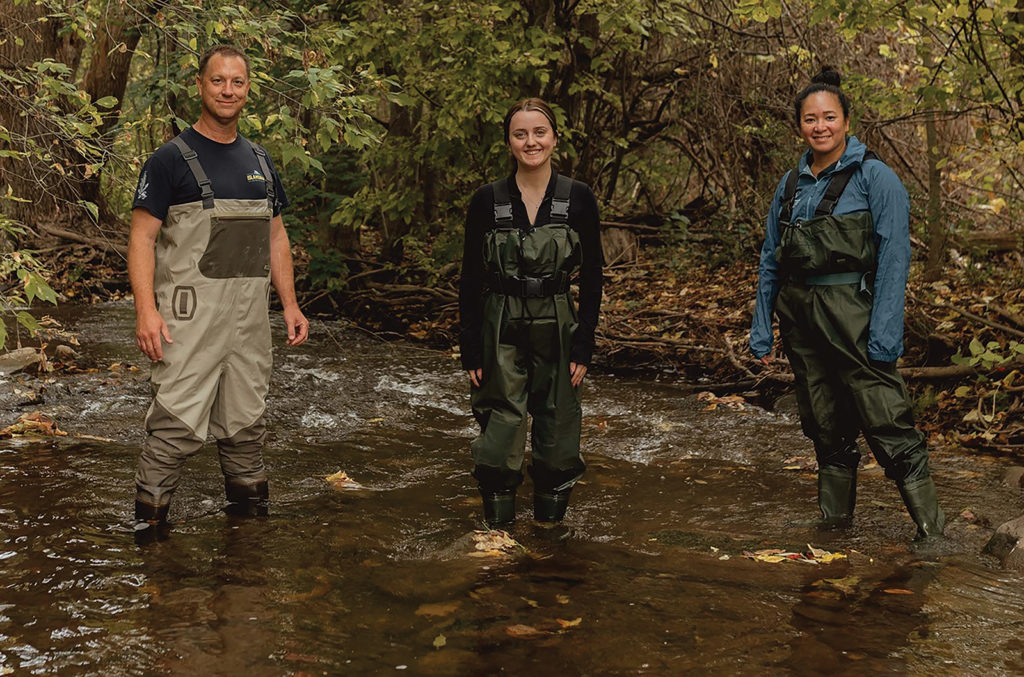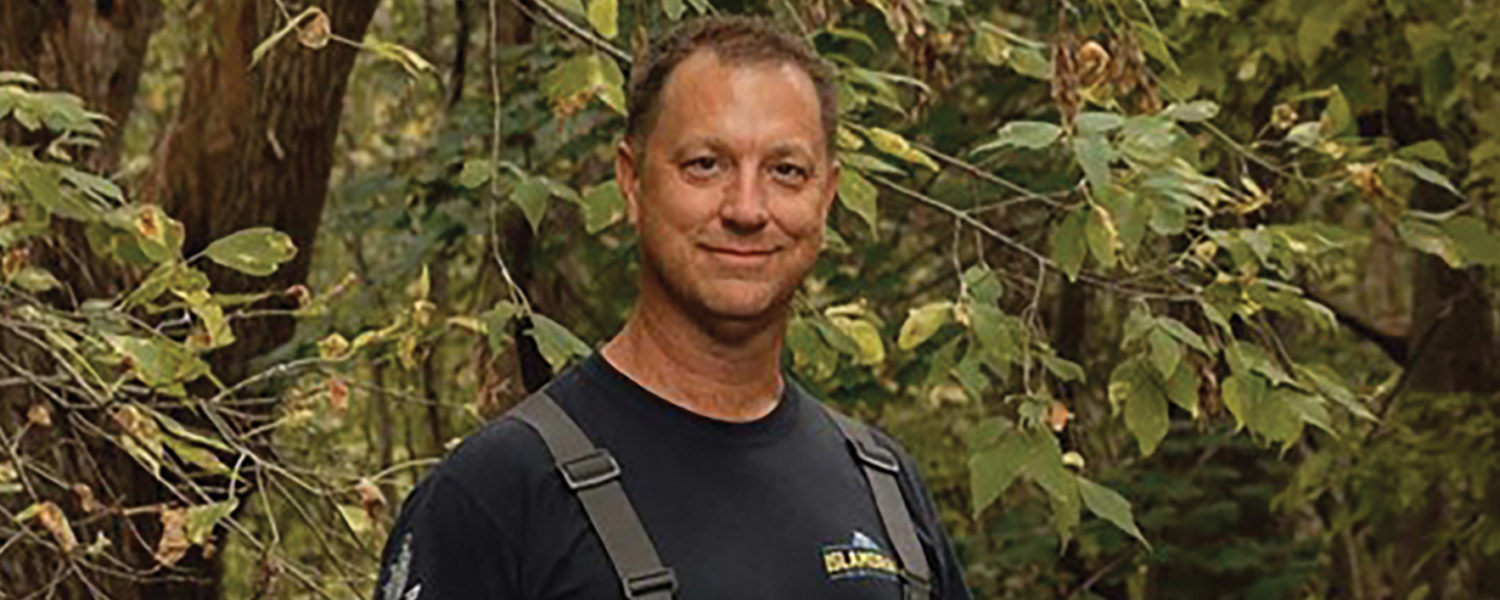Local Researchers Take Action to
Clean Up Our Freshwater Systems
While Helping its Crucial Biodiversity Recover
Story by Alley L. Biniarz
Photography by Shayenna Nolan, University of Windsor
Our freshwater biodiversity in the Great Lakes is in danger. As many other species in the world face the same narrative, it can feel challenging to keep up with, or to muster up the energy, to know what to do about these issues. Unlike many stories about species decline, this one is a story of hope, optimism, and collaborative effort towards greater change.
The recent research project Application and Assessment of Recovery Actions for Species at Risk Fishes and Mussels in the Lower Great Lakes, led by researcher and professor Trevor Pitcher along with a team of dedicated researchers and institutions, goes beyond academic documentation. They are committed to taking action—action that will show positive outcomes long after their careers are over.
“I’ve been doing research for 25 years and after 15 years in the field a switch turned on. I thought, ‘I don’t just want to document this loss,’” Trevor Pitcher shares the shift that happened within his career at the Department of Integrative Biology and the Great Lakes Institute for Environmental Research (GLIER).
Although the idea is over a decade in the making, the project took off a few years ago after receiving $850,000 in funding from the Department of Fisheries and Oceans’ Canada Nature Fund for Aquatic Species at Risk. From there, he and the team have been actively researching this critical threat on several species of fish and mussels and what they could do about preventing the continued loss of both the species and their habitats.
Dr. Pitcher explains the benefit of the grant and its ability to allow them to assess which methods work and which don’t. “With this grant we’re taking that next step beyond documenting decline and doing something to bring them back. We are working to restore some of the damage and taking the next step into restoration.”
There is a delicate balance between allowing Mother Nature to recover, while also lending a helping hand to the fatigued species. Dr. Pitcher says they’re looking at how they can restore the ecosystems without getting too involved. The good news is that they’ve already seen shifts in these ecosystems and that they’re being restored to some really good states. “We’ve researched an area like a farm field, opened it up to water, and looked at the after-effects. There are drastic changes in a short amount of time, just a year. But the animals aren’t coming back, they went down so hard.”

This is where the importance of captive breeding comes in. While the researchers work to allow the ecosystem to regulate, they give the fish and mussels a break from their stressful environments by placing them into their Freshwater Restoration Ecology Centre located in LaSalle, which is a collaboration between the town and the University. Once the ecosystem comes back into balance, they can release the species back into a healthier environment after they’ve regained their strength. “The answers are really so simple; we just have to give them and the environment a chance to heal. The species are stressed so often, so the captive breeding allows them some reprieve from that,” he explains.
One of the beautiful things about this research work is that the outcomes apply to so many species beyond the aquarian. Whether someone is interested in birds or butterflies or other species in danger, the documentation applies. Other divisions can look at their research, avoid the steps that don’t work effectively, and have the ability to impactfully improve situations to help a variety of species bounce back.
Unlike ocean ecosystems, freshwater biodiversity hasn’t received the same attention in the past, which Dr. Pitcher has been working to change. He shares that we depend on our Great Lakes systems for drinking water and if the biodiversity becomes unstable, we lose that incredible ecosystem service that helps keep our local waters clean. “You don’t see all of the work that native mussels do underwater to filter our waters. Since we don’t see it, we don’t think about it. If we take them for granted, all of that could be gone.”
Will the species come back? Dr. Pitcher says that even in a short time, they have already. They have and will continue to come back quite readily when we give them the chance to, and that leaves him feeling confident that we can make a difference. The animals are responding to the restoration, and that’s the message he wants to relay to the public.
He wants to echo that the issue of biodiversity loss in our freshwater supplies affects us directly here in Windsor-Essex; we are fortunate to be in close proximity to the Great Lakes, and it’s important not only to know what’s happening within our waters, but to continue to take action ourselves.
“When people are volunteering, planting trees, or cleaning up garbage they think they aren’t making a difference. All of these efforts that people do seems symbolic but we’re there behind them following those trees and we’re seeing an impact,” Dr. Pitcher says.
From high school kids volunteering to professionals cleaning up all the way to the sophisticated work that is done by researchers, it’s all important. These common issues collect towards the larger picture; any form of change helps in the mission to restore biodiversity. In fact, it depends on it.
“This isn’t an academic issue. Our project isn’t just compiled of academics and researchers, we have people on the ground doing the work and we couldn’t do it without them: the farmers, the volunteers, our partners, and everyone who is involved. This is an ‘us’ issue, and we need to work together,” Dr. Pitcher adds.
We may not see the change today, or even a year from now, and that’s why climate work is inherently both selfless and selfish. It’s “selfish” work because by saving these different species, we’re ultimately helping to save the human species down the line. The selfless part is that the big picture change is made up of thousands of individual acts taken today—of planting trees “knowing that they shall never sit in the shade of their foliage; knowing that only others will enjoy the shade.”
This is what Dr. Pitcher and his team are all about: creating positive experiences and knowing that they may never see the largest outcome or impact of their work. But someday, someone will. And we have to start somewhere.
Readers can look forward to updates on the outcomes of the grant in the coming months at their open house, which will be located at the Freshwater Restoration Ecology Centre in LaSalle. More information is available at pitcherlab.ca/frec.




Add comment